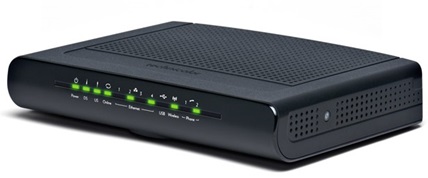
Picture: Technicolor 7200
If you scroll through the threads in our Community, you will come across the term «Bridge Mode» many times. «What can the Bridge Mode function do?», asks one user. Another wants to know: «How can I put my modem into Bridge Mode?» Here, we will cast light on the matter and explain what it is all about.
Bridge Mode allows you to connect an external router. This acts as an amplifier for the existing internal router. In other words: Bridge Mode can be used to expand a computer network and – in the case of a WLAN router, for instance – to expand and amplify the range.
Some people like to have things complicatedSome users are not satisfied with the signal strength that they can achieve with their WLAN modem. They buy their own independent router and put the modem into Bridge Mode. Whereas the modem previously served both functions, that is to say modem and wireless router, it now serves solely as a bridge (receives an external IP address and transmits this in identical form).
Of streets and house numbersThe question that now arises is: what are the router and IP address? Inside the Internet modem is the router, which has a special «distribution task». The router assigns the devices connected to the same computer network a so-called internal IP address and identifies this. This is comparable to every house in the same street having a different house number.
Like the router, the modem is also a network device that requires an IP address, that is to say a street name. And so as soon as the modem is connected to the Internet, it obtains an external IP address. This allows the modem to be contacted from anywhere in the world and vice versa.
IPs – that is to say the house numbers – are usually made up of four blocks of numbers. Each number block has a particular task to play. Whereas the first two blocks (e.g.: 192.168.) address the global and private network, the last two blocks (such as .0.2) are for further sub-networks (device groups) and the numbering of individual devices. An IP might be as follows, for example: 192.168.0.2.
Sent to work in the cellarThe combination of a separate router and the modem in Bridge Mode offers several configuration possibilities, both physically and virtually: the router can be moved to a different location, so that perfect WLAN reception can be enjoyed in the cellar, for example. This could be useful for when a wife sends her husband down to the cellar to work, for instance. And so individual networks can be set up on each floor with their own devices (useful for printers on the same floor – and for users who are too lazy to go up or down stairs!). These floor networks would all know each other within the house and would converge in the living room to access the Internet via the modem.
**Let’s get started
**Now that we have explained the most important terms, we can get down to business: How do I put my modem into Bridge Mode? With the Technicolor WLAN, for instance, you enter the IP address 192.168.0.1. in your browser. After this, you use the username and password from our homepage (see further below) or a personalised login. You will now find the «Switch Mode» section under the «System» menu item. «Router Mode» is selected by default here. You can change this to «Bridge Mode» and then confirm the change with «Save». The modem will now be rebooted and comes online in Bridge Mode. You will find more information about this and about which other modems from upc cablecom you can use for Bridge Mode here. If you have already got a router and want to use it with the Horizon HD Recorder WLAN Modem in Bridge Mode, you will find useful tips here.
Hands off – only for professionalsBut be warned: these upgrades require expert knowledge and are not recommended for normal users. Because if, through manipulation, a device is given the same IP as the modem or the router, or does not have any IP, the Internet itself will no longer work: the house in the street loses its drive.
**Bridge Mode with TC7200
**In this connection, a change was made to the modem TWG870 two months ago. It was particularly popular among those users who used the device in Bridge Mode. Following the deployment of IPV6 in our network, the TWG modem no longer worked in Bridge Mode. upc cablecom replaced this with the Technicolor TC7200 modem which is also able to work in Bridge Mode.